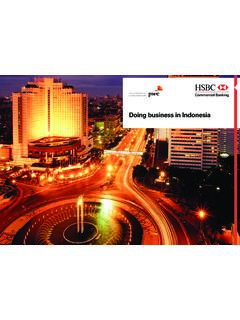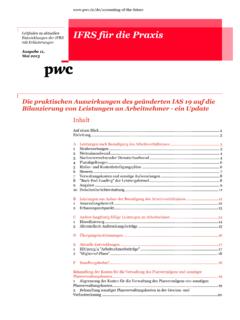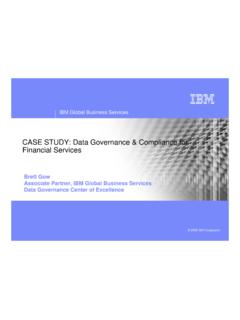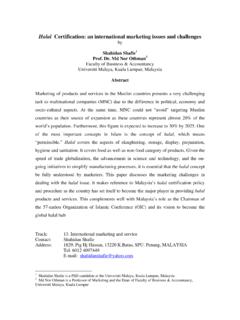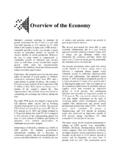Transcription of st CEO Survey Driving change: No magic solutions, …
1 CEO SurveyDriving change: No magic solutions, just hard workKey findings from the banking and capital markets industry2 | PwC s 21st CEO Survey : banking and capital markets6 Growing pains10 Building trust13 The way forwardX15 Conclusion16 21st CEO Survey Methodology17 PwC industry contactsContents3 | PwC s 21st CEO Survey : banking and capital marketsIntroductionThe percentage of CEOs who report being very confident about their companies ability to boost revenue growth during the next 12 months and over the next three years both edged lower when compared to a year ago. What s more, they are less confident in that fact than the average CEO over the next 12 lukewarm outlook is likely a reflection of industry returns that, while rising, are still below targets in most developed markets. Some BCM organisations are, of course, faring better than others. As the PwC s 21st CEO Survey findings underline, the big differentiator is digital transformation, and banking and capital markets (BCM) CEOs find themselves in a good but not great mood this year, according to results from PwC s 21st CEO Survey .
2 More than half report being bullish about economic growth 57% believe the global economy will improve over the next 12 months, compared to 30% the year earlier. Yet that economic optimism hasn t translated into increasing confidence in their own prospects. 38%of BCM CEOs are very confident about their companies ability to boost revenue growth over the next 12 months, down from 40% the year before45%of BCM CEOs are very confident about their companies ability to boost revenue growth over the next three years, down from 48% the year before4 | PwC s 21st CEO Survey : banking and capital marketsthe breakthrough innovation and growth boost that stem from it. Organizations that get this right will find opportunities to positively transform the customer experience and put space between themselves and competitors. Driving this type of change is proving exceptionally challenging, however. In fact, the speed of technological change is now on the list of worries that are most likely to keep BCM CEOs awake at night, along with over-regulation (see exhibit 1).
3 And as the work BCM organisations have done over the past decade to implement the regulatory overhaul has shown, there are no quick solutions to implementing such complex and far-reaching changes to an organization. What s keeping banking and capital markets CEOs up at night? Q How concerned are you about the following threats to your organisation s growth prospects?Exhibit 1 Over-regulationSpeed of technological changeGeopolitical uncertaintyCyber threats 89%86%85%85%Source: PwC s 21st CEO Survey , banking and capital marketsiChart shows percentage of banking and capital markets CEOs stating extremely or somewhat concerned 5 | PwC s 21st CEO Survey : banking and capital marketsDavid Hoffman banking and Capital Markets Leader PwC USMany BCM organisations that have tried to bring in technologies such as robotic process automation (RPA), blockchain, and artificial intelligence (AI) without streamlining and rationalising their core processes have quickly come undone. Technology can t reinvigorate innovation and returns without new ways of working ( human/machine collaboration) and a rethinking of how to connect with clients, including business and capital markets as well as retail this in mind, BCM organisations face a long and tough road ahead.
4 But it is a path they must take, or risk the competition leaving them behind. Growing pains6 | PwC s 21st CEO Survey : banking and capital marketsThis year s Survey shows that BCM CEOs view their sector as one of the most disrupted in the global economy (see exhibit 2) and that technology is the main game-changer not surprising as this has been the reality for some years | PwC s 21st CEO Survey : banking and capital marketsBanking and capital markets CEOs report existing in one of the most disrupted sectors Q How disruptive do you think the following trends will be for your business over the next five years?Exhibit 2 InsuranceBanking and capital marketsTechnologyCommunicationsEntertain ment and media36%33%39%48%37%22%23%26%13%Source: PwC s 21st CEO Survey , banking and capital marketsiChart shows percentage of banking and capital markets CEOs stating very disruptive Increase in number of significant direct and indirect competitors (traditional and new)Changes in distribution channelsChanging customer behaviourChanges in core technologies of production or service ( AI, robotics, blockchain) Changes in industry regulation20%30%28%24%28%30%29%9%33%29%2 7%22%40%37%43%55%What s more revealing, however, is the status of the other disruptors: the relatively low level of perceived disruption coming from new competition would suggest that the heat from FinTech is easing.
5 Rather than a potential rival, FinTech businesses are coming to be seen as a valued source of innovation and disruption brought by changes in customer behaviour, however, are very much on CEOs radar: 81% expect it to be either very or somewhat disruptive to their business over the next five years. This goes hand-in-hand with another big worry: changes in core technologies. More than three quarters (76%) of CEOs reported thinking that changes in core technologies of production or service provision ( artificial intelligence, robotics, blockchain) will be either very or somewhat disruptive to their business over the next five years. Addressing changes in customer behaviour can t be done successfully without first dealing with the technological disruption that drives | PwC s 21st CEO Survey : banking and capital marketsHarnessing automation, blockchain, and AI will enable BCM organisations to drive down costs, but also serve more customers well, optimise trading strategies, and target valuable new segments.
6 Already some investment banks are using advanced technologies to reach into retail markets and services that would once have been reserved for large corporates. In turn, sharper customer intelligence (CI) allows BCM organisations to target and tailor solutions more precisely than ever. Eventually, as data proliferation overwhelms human comprehension and customer expectations become ever more exacting, digital transformation could offer the only way to keep BCM businesses in the big challenge, of course, is figuring out how to organise processes and procedures in order to capitalise on the digital potential. It s generally not the technology itself that creates the difficulties systems are becoming more powerful, more intuitive, and easier to implement and use. Rather, most of the problems stem from the familiar old snags of process fragmentation and IT incompatibility. Unless these deficiencies are sorted as part of a digital transformation, no amount of investment can deliver real benefits.
7 Capitalising on digital potential is also as much about talent as tech people, rather than systems, drive innovation and realise its full commercial potential. As the study s findings highlight, attracting digital talent is notoriously hard. Less than 20% of BCM CEOs say they see it as easy. While much of the current focus is on bringing in app developers, robotics engineers, and other specialists, it s just as important to ensure that tech awareness permeates the entire organisation, including senior leadership. It s also important to consider how to organise talent as humans and machines begin to work so closely as part of a hybrid workforce. Most BCM CEOs say they are still trying to work out how to make the most of the collaborative potential. When thinking about their people strategy for the digital age, less than half (44%) say they are clear about how robotics and AI can improve customer experience, for CEOs say they are clear about how robotics and AI can improve the customer experience9 | PwC s 21st CEO Survey : banking and capital marketsLeaders must also realize the common anxieties surrounding automation and AI.
8 These include consumer reluctance to be served by a robot instead of a human and what some see as the risk of market fluctuations from high-speed algorithm-based trading. Within the workforce itself employees may be concerned about losing jobs to automation or resist new ways of working. When asked whether they are creating transparency around the effects of automation and AI to help build trust within their workforces, two-thirds of BCM CEOs said yes, and a further 10% say they plan to do so in the next 12 months. However, more than 20% aren t addressing this issue and have no immediate plans to do so. Building trust10 | PwC s 21st CEO Survey : banking and capital marketsCI, in which companies use data management platforms to compile information profiles about customers with the aim of targeting goods and services better, is emerging as the key to revenue growth and profitability. But BCM organisations are finding it difficult to win the trust, let alone the love, that makes customers so ready to share their data with their mobile, social media and search engine providers.
9 To that end, the fact that only 60% of BCM CEOs see a lack of trust as a threat to their growth prospects is worrying. 11 | PwC s 21st CEO Survey : banking and capital marketsAssuring customers that their interests come first is clearly crucial in winning this trust, even if this comes up against conflicting priorities such as sales targets. Tellingly, there are already signs that businesses that have used the US Department of Labor fiduciary rule as an opportunity to strengthen customer trust are seeing higher returns. It s vital to assure customers that their data will be secure, used responsibly, and, indeed, imaginatively. The importance of secure, sensitive, and beneficial management of data and the stakeholder trust that surrounds this was highlighted in PwC s 20th CEO Survey . More than three-quarters of the BCM CEOs in that study said they believed that how we manage people s data will differentiate us, but it s harder to gain and keep trust in an increasingly digitised world.
10 A full 96% also said that to some degree or to a strong degree they believed that breaches of data privacy and ethics will have a negative impact on stakeholder trust over the next five years and are addressing the issue as a high priority. This year, 82% of BCM CEOs say they are creating transparency in the usage and storage of data as part of their efforts to strengthen consumer importance of cyber protection to customer trust underlines the extent to which cyber threats are a strategic rather than just an IT risk. Little wonder then that nothing is more likely to keep BCM CEOs awake at night: 54% of CEOs said they were extremely concerned about cyber threats, while 35% said they were somewhat BCM CEOs are investing more heavily in cybersecurityCustomer-focused cybersecurity demands a balance between appropriate control and the ease and speed of multichannel service that retail and corporate clients have come to expect. This, in turn, means building cyber security into both the overhaul of the customer journey and enterprise risk management (ERM).







